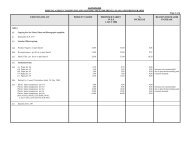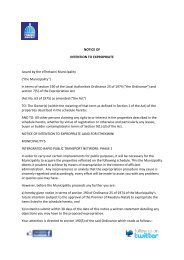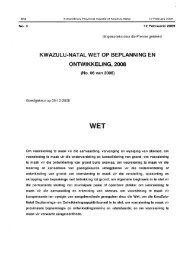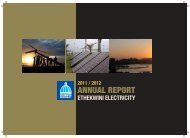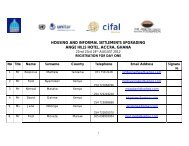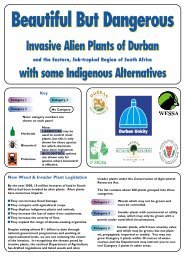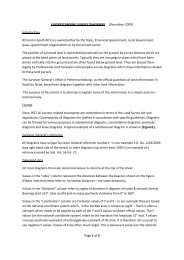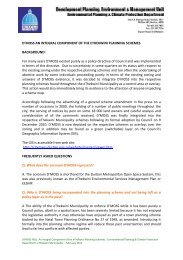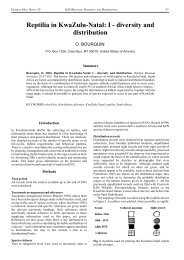Mullin, S. K., Taylor, P. J. & Pillay, N. 2004. Skull size and ... - Durban
Mullin, S. K., Taylor, P. J. & Pillay, N. 2004. Skull size and ... - Durban
Mullin, S. K., Taylor, P. J. & Pillay, N. 2004. Skull size and ... - Durban
You also want an ePaper? Increase the reach of your titles
YUMPU automatically turns print PDFs into web optimized ePapers that Google loves.
MULLIN_08 13/08/04 12:45 Page 13<br />
material was characterised by a narrow toothrow,<br />
larger M1 , more elongated bullae, a wider rostrum<br />
<strong>and</strong> shorter sphenopalatine. Material from<br />
Angola, the Okavango Delta <strong>and</strong> the Limpopo<br />
Province, South Africa had a wider toothrow (in<br />
particular M2 ), smaller bullae <strong>and</strong> a narrower skull.<br />
P R O O F<br />
MICRO-SCALE PATTERNS<br />
The variation seen between the DRC populations<br />
was not the result of isolation by distance as shown<br />
by the Mantel’s t-test (t = 3.18, p = 0.99). Selected<br />
data subsets were used to resolve taxonomic questions<br />
between OTUs, which were analyzed in different<br />
combinations (Figs. 5, 6). In particular, we<br />
analyzed subsets from east, central <strong>and</strong> west Africa<br />
in an attempt to determine group boundaries <strong>and</strong><br />
to clarify the ambiguous results for material from<br />
Angola (D. incomtus), Malawi, Mozambique,<br />
Cameroon, Congo <strong>and</strong> the Democratic Republic<br />
African Dasymys systematics<br />
FIG. 4. – Plot of the first two variates of a multi-group canonical variates analysis of the ventral skull partial warp matrix. The thin-plate<br />
splines (at a magnification factor of 10) depict ventral skull deformations along the first <strong>and</strong> second variates. , West African D. rufulus;<br />
〈, D. foxi, π, Ethiopia <strong>and</strong> Sudan; , D. i. griseifrons; ?, Cameroon, Central African Republic, Congo, Democratic Republic of Congo;<br />
⊃, D. i. longipilosus; σ, East Africa; ∠, D. montanus; , Malawi, Mozambique <strong>and</strong> Tanzania; τ, D. incomtus from Angola;<br />
υ, D. nudipes; ρ, Okavango Delta; ≤, Zambia; , Zimbabwe; θ, Limpopo <strong>and</strong> Mpumalanga Provinces, South Africa; ϖ, KwaZulu-Natal<br />
Province, South Africa; ÷, D. i. capensis. OTUs (defined in Table 6.1) containing karyotyped individuals are demarcated by the diploid<br />
number.<br />
MAMMALIA • 2004 • 68 (2)<br />
of Congo (Figs. 5A, C, D, 6B, C, D). Although<br />
there appeared to be a geographic structure in the<br />
dataset, <strong>and</strong> each of the CVA plots had significant<br />
(p < 0.01) Wilks values, there were no clear<br />
boundaries between OTUs. However, the data<br />
did confirm the morphological distinctness of the<br />
following: D. i. capensis (Figs. 5A: cluster B3, 5B:<br />
cluster B2 <strong>and</strong> 6A); D. nudipes (Figs. 5B: cluster<br />
C, 5C: cluster B <strong>and</strong> 6d); D. montanus (Fig. 5D);<br />
D. incomtus from Angola (Figs. 5B: cluster A;<br />
6D), Okavango Delta (Fig. 5B: cluster B1),<br />
D. i. incomtus from Limpopo <strong>and</strong> Mpumalanga<br />
Provinces (Figs 5A: cluster B1 <strong>and</strong> B2, <strong>and</strong> 6A)<br />
<strong>and</strong> D. i. incomtus from the KwaZulu-Natal<br />
Province (Figs 5A: cluster B2b <strong>and</strong> 6A).<br />
Fig. 5A shows a clear separation between OTUs<br />
representing Malawi, Mozambique, Tanzania<br />
<strong>and</strong> Zambia (Cluster A) <strong>and</strong> Zimbabwe <strong>and</strong><br />
South Africa (Cluster B). Within Cluster B, OTUs<br />
13


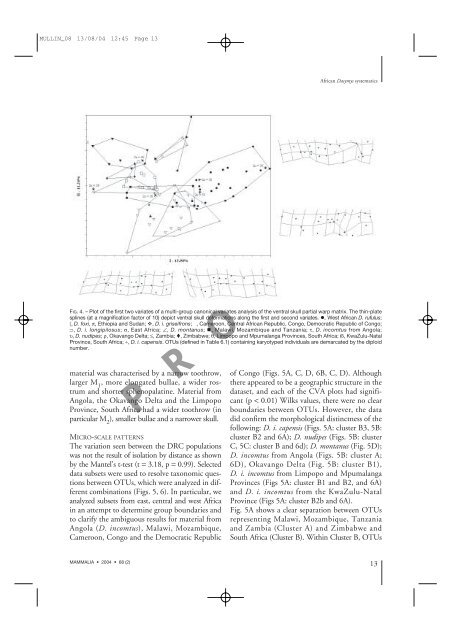
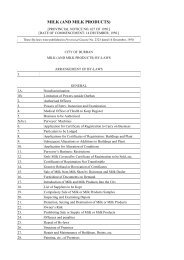
![INK Environmental Sustainability Booklet [19 MB] - Durban](https://img.yumpu.com/22025104/1/190x136/ink-environmental-sustainability-booklet-19-mb-durban.jpg?quality=85)

